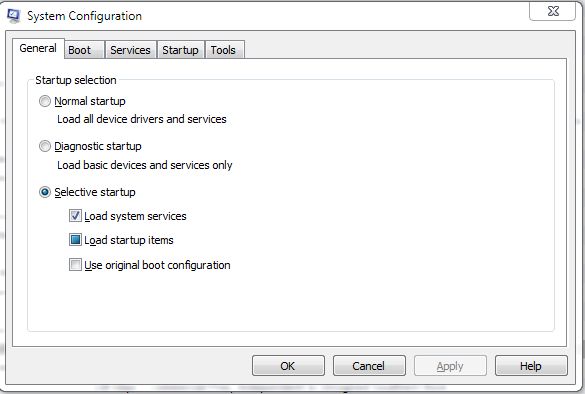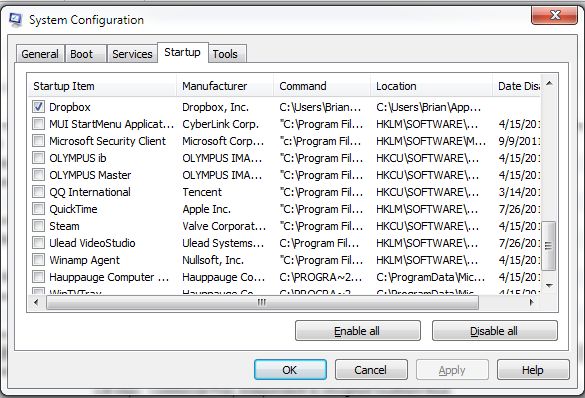If you’ve just bought a new computer or you’ve loaded a ton of new software on your old one, it’s most likely not running as fast as it could. Sure, you might have lots of RAM (memory) and the latest, greatest version of Windows but your computer is still being choked by software that starts when your computer starts…but doesn’t have to.
Additionally, malware or spyware can weasel its way into your system and clog it up. Do you really need all of those toolbars? Does your DVD burning software really have to run the whole time you are using your computer? Here’s how to trim the fat:
1. Click Start. In the search menu there, type in msconfig , just like that with nothing else like commas or capitals.
2. Wait for a bit and your System Configuration menu will pop up. It looks like this:

3. The tab we are interested in today is the ‘Startup’ tab, fourth from the left. Click it. This is what should see now:

4. This is a screen capture of my startup menu. I have scrolled down to show you the things that I have turned off. When I turn these things off, Winamp Agent for instance, this doesn’t mean that this program won’t run. All it means is that it won’t run ALL the time. I can always start the program manually, wait for a second or two, and use it. It doesn’t have to be running in the background. There are many things that you want to run all the time, your anti-virus software for instance.
5. Before you change anything here, check to see what it is that you are disabling. Your computer will still run if you turn everything off. It just won’t run very well. Your virus protection probably won’t work, your scanner won’t start, maybe your mouse won’t have all of its functions…things like that. Do your best to figure out what each one does. Most are self-explanatory but some are not. Realtek Audio Manager might seem safe to turn off but that’s my onboard sound system. I like my tunes so I can’t turn that off.
6. If you have malware or spyware, most likely it is on this list somewhere. Before you change anything here, download Malware Bytes and run it. It’s free, quick and will tell you if you have any bad stuff that is slowing down your surfing. It will get rid of anything that shouldn’t be there.
7. If you see something here that you don’t recognize, google it and see what comes up. Usually the site that tells you what it is will also tell you if you need to have it running. There are many very helpful forums around the Internet (Microsoft runs a few) that will give you an answer on anything you ask. If you decide you don’t need it to run all the time, simply uncheck the box to the left of it.
8. You can use trial and error here, too. Turn off a few things, usually near the bottom, and see if your computer runs faster. I can almost guarantee that if you’ve noticed things running slowly, this is the place to fix it. Get familiar with this little menu and you’ll have a faster, more responsive computer. It probably won’t crash as much either. Sometimes there are conflicts with programs that are running at the same time. If you stop a certain program from loading, you might find that your ‘BSODs’ (Blue Screen of Death) happen less often.
Good luck! You can’t really screw anything up here so don’t worry. You can disable everything here and then start them one by one if you want. Modern computers have lots of ram but if you’re saddled with an older one with less ram, this is a good place to start if you’re looking to speed it up.
Thanks for reading! Comments are welcome. Follow me on Twitter: @_BrianMahoney
